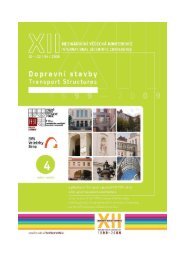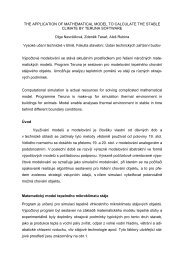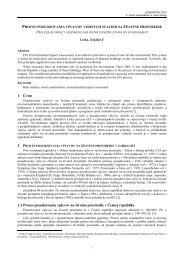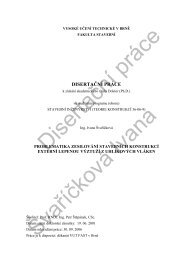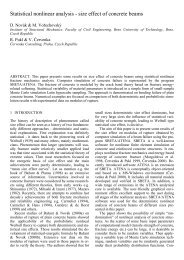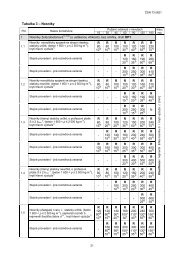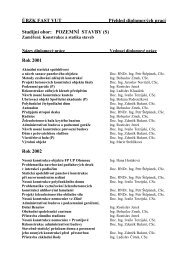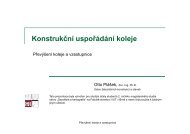Annotation of the project
Annotation of the project
Annotation of the project
Create successful ePaper yourself
Turn your PDF publications into a flip-book with our unique Google optimized e-Paper software.
1<br />
JUNIORSTAV 2011<br />
3. Water Management and Water structures<br />
RISK ANALYSIS METHODOLOGY AND ITS IMPLEMENTATION ON CONTINUOUS AND<br />
INTERMITTENT WATER SUPPLY SYSTEMS<br />
Alayoubi Mzayan 1 , Valešová Martina 2 , Tuhovčák Ladislav 3<br />
Abstract:<br />
The paper presents <strong>the</strong> methodology <strong>of</strong> risk analysis for public water supply systems, which is a systematic predefined<br />
process to identify, assess and evaluate <strong>the</strong> hazards and undesired events in existing water supply systems. The<br />
methodology is associated with a simple and practical s<strong>of</strong>tware tool that analyses <strong>the</strong> risk and interprets <strong>the</strong><br />
consequences as a clear form to support risk management and decision-making procedures.<br />
The WaterRisk methodology and s<strong>of</strong>tware tool have been implemented and tested on many simple and complex<br />
water supply systems in Czech Republic with continuous supply patterns. The paper discuses <strong>the</strong> results <strong>of</strong> <strong>the</strong>se case<br />
studies and suggest <strong>the</strong> required development <strong>of</strong> <strong>the</strong> s<strong>of</strong>tware tool that should be done to deal with <strong>the</strong> intermittent<br />
supply also.<br />
Key words:<br />
Hazards, intermittent, risk analysis, undesired events and water supply.<br />
1 INTRODUCTION:<br />
Risk management is to assess, control, and minimize risk to acceptable levels in <strong>the</strong> entire water supply system<br />
after subdivided it into subsystems (Source, Treatment system, and distribution and plumbing networks) from source to<br />
tap.<br />
WaterRisk <strong>project</strong> carried out by Institute <strong>of</strong> Municipal Water Management / BUT; Local water supply Utility, and<br />
National Institute <strong>of</strong> Public Health in Brno, Czech Republic during 2006-2010. This <strong>project</strong> developed risk analysis<br />
methodology and a s<strong>of</strong>tware tool in <strong>the</strong> frame <strong>of</strong> <strong>the</strong> HACCP methodology (Hazard Analysis at Critical Control Points)<br />
to achieve high level <strong>of</strong> drinking water quality and safety.<br />
Risk analysis methodology is a systematic pre-defined process to identify, assess, and rank <strong>the</strong> weaknesses and<br />
shortcomings <strong>of</strong> an existing water supply system as a first step <strong>of</strong> risk management <strong>of</strong> that system, hazards that may<br />
ei<strong>the</strong>r affect water quality or interrupt <strong>the</strong> service and <strong>the</strong> undesired events that are consequences <strong>of</strong> <strong>the</strong> hazards will be<br />
specially focused on.<br />
Intermittent water supply is not accebtable in Czech Republic, only temporary emergency supply is allowed under (<br />
§ 109 law 254/2001Sb. About water), so that <strong>the</strong> intermittent supply is considered as undesired event that related to<br />
distribution system’s section in <strong>the</strong> catalogue <strong>of</strong> UEs, more details will be presented.<br />
2 RISK ANALYSIS METHODOLOGY :<br />
2.1 Terminology <strong>of</strong> risk analysis:<br />
� Undesired event UE:<br />
It is <strong>the</strong> state when an element (system, part, or product) loses its required property or ability to fulfil <strong>the</strong> required<br />
function in specific conditions.<br />
� Hazard:<br />
It is a potential source (reason) <strong>of</strong> <strong>the</strong> UE.<br />
� Risk:<br />
The common definition <strong>of</strong> <strong>the</strong> risk is <strong>the</strong> combination <strong>of</strong> <strong>the</strong> frequency, or probability, <strong>of</strong> occurrence and <strong>the</strong><br />
consequence <strong>of</strong> an undesired event.<br />
1<br />
Mzayan Alayoubi, Ing., Brno University <strong>of</strong> Technology, Civil engineering faculty, institute <strong>of</strong> Municipal water Management, Brno 60200, Žižkova<br />
17, AlayoubiM@study.fce.vutbr.cz<br />
2<br />
Martina Valešová, Ing., Brno University <strong>of</strong> Technology, Civil engineering faculty, institute <strong>of</strong> Municipal water Management, Brno 60200, Žižkova<br />
17.<br />
3<br />
Ladislav Tuhovčák, Ing, CSc, Brno University <strong>of</strong> Technology, Civil engineering faculty, institute <strong>of</strong> Municipal water Management, Brno 60200,<br />
Žižkova 17, Tuhovcak.l@fce.vutbr.cz
JUNIORSTAV 2011<br />
3. Water Management and Water structures<br />
For <strong>the</strong> purposes <strong>of</strong> water supply system risk analysis, that definition was accepted, developed, and expressed as<br />
follows:<br />
R=P*C (1)<br />
While:<br />
R stands for <strong>the</strong> risk.<br />
P stands for probability <strong>of</strong> occurrence <strong>of</strong> UE.<br />
C stands for consequence <strong>of</strong> <strong>the</strong> event.<br />
� Risk analysis RA:<br />
RA is a structured process identifying both <strong>the</strong> probability <strong>of</strong> occurrence <strong>of</strong> an undesired event, and <strong>the</strong> extent <strong>of</strong><br />
adverse consequences arising from <strong>the</strong> event, it tries to answer <strong>the</strong> following three principal questions:<br />
What can go wrong? (UE and hazard)<br />
How likely is it? (Frequency analysis)<br />
What are <strong>the</strong> consequences? (Consequence analysis)<br />
2.2 The main principals <strong>of</strong> <strong>the</strong> methodology:<br />
Currently <strong>the</strong>re are many methods to analyse risk in water supply systems. While choosing <strong>the</strong> appropriate method,<br />
many considerations should be taken in to account, The method should be suitable and sustainable for <strong>the</strong> existing<br />
system, It should <strong>of</strong>fer results in forms that present clear comprehensive <strong>of</strong> <strong>the</strong> risk.<br />
Based on those and o<strong>the</strong>r considerations, <strong>the</strong> developed methodology has been formulated, <strong>the</strong> main principals <strong>of</strong> it<br />
are:<br />
1. It is suitable and sustainable for existing water supply systems,<br />
2. It <strong>of</strong>fers <strong>the</strong> results in forms that support decision-making system,<br />
3. It is adaptable and explicitness,<br />
4. It is supported by a simple and practical s<strong>of</strong>tware tool that deals with <strong>the</strong> whole components <strong>of</strong> <strong>the</strong> water<br />
supply system,<br />
5. The evaluation procedures are objective and clear,<br />
6. Distinguishes between simple and complex systems,<br />
7. Interprets <strong>the</strong> results in a context,<br />
8. Implements qualitative analysis techniques.<br />
2.3 Risk structuring:<br />
It is important to clarify what will be analyzed (part x unit); which sort <strong>of</strong> WSS it is (simple x complex), and what<br />
level <strong>of</strong> details will be distinguished. After defining and describing water supply system, <strong>the</strong> next analysis’s step can be<br />
performed.<br />
Water supply system is divided into three subsystems that are analyzed separately:<br />
1. Water source,<br />
2. Water treatment plant,<br />
3. Water distribution (accumulation, pumping, and distribution)<br />
The analysis distinguishes between two types <strong>of</strong> systems – simple and complex.<br />
Criteria Limitation Studied system<br />
Population<br />
0 up to 2000 Simple system<br />
2001 and more Complex system<br />
The number <strong>of</strong><br />
connections<br />
Network’s length<br />
The volume <strong>of</strong> <strong>the</strong><br />
consumed water (m3/year)<br />
Complexity <strong>of</strong> <strong>the</strong> used Simple system<br />
0 up to 500 Simple system<br />
501 and more Complex system<br />
0 up to 10000 Simple system<br />
10001 and more Complex system<br />
0 up to 75000 Simple system<br />
75001 and more Complex system<br />
2
technology for water<br />
treatment<br />
System is without water treatment plant, or<br />
with an aeration, or carbon dioxide removing<br />
treatment technology.<br />
Complex system<br />
Any more complex treatment technology<br />
than that specified for <strong>the</strong> simple system exist in<br />
<strong>the</strong> system, so it considered complex.<br />
Table.1. Simple and complex systems criteria<br />
2.4 Generic framework <strong>of</strong> risk analysis <strong>of</strong> water supply systems:<br />
Input data Catalogue <strong>of</strong><br />
hazards and risk<br />
System<br />
description<br />
Questionnaire<br />
Risk<br />
Influencing Factors<br />
Vulnerability<br />
UE_345: Intermittent water<br />
supply<br />
2.5 Hazard analysis:<br />
2.5.1 Hazard identification:<br />
influencing actors<br />
Fig.1. Generic framework <strong>of</strong> risk analysis <strong>of</strong> water supply system<br />
2.5.2 The catalogue <strong>of</strong> hazards and risk influencing factors:<br />
2.5.3 Hazard estimation:<br />
2.6 Risk estimation:<br />
Database <strong>of</strong><br />
WSS elements<br />
Frequency<br />
analysis<br />
Consequences<br />
analysis<br />
2.6.1 Undesired events identification:<br />
In this methodology, 58 undesired events have been defined, <strong>the</strong>y are:<br />
1. 11 UEs for water source,<br />
2. 6 UEs for treatment plant,<br />
3. 41 UEs for distribution system + UE_345.<br />
3<br />
Catalogue <strong>of</strong><br />
undesired events<br />
Undesired event<br />
R = P x C<br />
Database <strong>of</strong> risk<br />
reducing measures<br />
JUNIORSTAV 2011<br />
3. Water Management and Water structures<br />
Hazard<br />
identification<br />
And<br />
Undesired<br />
Events<br />
identification<br />
Risk<br />
estimation<br />
Risk<br />
evaluation<br />
Risk<br />
reduction
JUNIORSTAV 2011<br />
3. Water Management and Water structures<br />
2.6.2 Undesired events catalogue:<br />
UE catalogue is a specific list <strong>of</strong> undesired events or failures <strong>of</strong> particular parts <strong>of</strong> <strong>the</strong> WSS with interaction to <strong>the</strong><br />
formerly identified hazards and risk-influencing factor that may cause <strong>the</strong>m.<br />
UE is defined for a certain part <strong>of</strong> <strong>the</strong> system; <strong>the</strong>re may be more than one UE for each part and each <strong>of</strong> <strong>the</strong>m must<br />
be properly described (what, when, how –scenario).<br />
The content <strong>of</strong> <strong>the</strong> catalogue is generated by <strong>the</strong> s<strong>of</strong>tware application according to <strong>the</strong> type <strong>of</strong> WSS, identified<br />
hazards, and <strong>the</strong> analysed part.<br />
2.6.3 Frequency analysis<br />
The major problem is always how to calculate or estimate <strong>the</strong> values <strong>of</strong> C and P under uncertainty - lack <strong>of</strong> data,<br />
insufficient historical records and/or unreliable data, uncertainty <strong>of</strong> failure detection.<br />
This problem was effectively solved, by using frequency instead <strong>of</strong> ma<strong>the</strong>matical probability <strong>of</strong> occurrence <strong>of</strong> UE,<br />
based on some chosen factors or indicators, and on limits <strong>of</strong> categories.<br />
In risk analysis <strong>of</strong> water supply system, <strong>the</strong> analysis proceeds bottom-up-ward, that mean it begins with choosing<br />
<strong>the</strong> element from <strong>the</strong> lowest level <strong>of</strong> <strong>the</strong> system for which enough information is available. Several tables are created to<br />
describe <strong>the</strong> different failure modes that may occur, and <strong>the</strong>n <strong>the</strong> consequence <strong>of</strong> <strong>the</strong> failure for each <strong>of</strong> <strong>the</strong>m is<br />
considered as a failure mode when <strong>the</strong> consequences are analyzed at <strong>the</strong> next higher level.<br />
Frequency <strong>of</strong> occurrence Risk factor<br />
No failure 0<br />
low 1<br />
Moderate 2<br />
high 3<br />
Unevaluated factor N<br />
Table.2. Risk factors<br />
After all main factors for UE are defined; Sc is set by summing all risk factors, and <strong>the</strong>n SCMAX can be<br />
determined by:<br />
SCMAX = 3 x n (2)<br />
While n stands to <strong>the</strong> number <strong>of</strong> main factors for <strong>the</strong> UE, it does not take into account <strong>the</strong> unevaluated factors.<br />
The rate SC /SCMAX sets <strong>the</strong> probability<br />
The rate SC /SCMAX Reference <strong>of</strong> <strong>the</strong> probability<br />
SC /SCMAX = 0 P0- zero probability<br />
0 < SC /SCMAX ≤ 0,30 P1- unlikely ( < 1x year)<br />
0,30 < SC /SCMAX ≤ 0,60 P2 – probable ( 1x week up to year)<br />
0,60 < SC /SCMAX P3 – certain ( 1 x week and more)<br />
Table.3. probability<br />
2.6.4 Hotspot:<br />
Hotspot is an indicator for <strong>the</strong> dominant risk factor, which has extreme significant, and influence than o<strong>the</strong>r existing<br />
factors; it may be one Hotspot for each UE or more than one.<br />
Hotspot should have high risk factor with probability P3.<br />
2.6.5 Consequences analysis<br />
The consequences are divided into four categories depending on <strong>the</strong>ir characters:<br />
1. Health consequences, CHEALTH;<br />
2. Economic consequences, CECON;<br />
3. Social consequences, CSOC;<br />
4. Environmental consequences, CENV;<br />
5. In addition to one common value CTOTAL<br />
4
While:<br />
CTOTAL = max (CHEALTH, CECON, CSOC, CENV) (3)<br />
To evaluate each <strong>of</strong> <strong>the</strong> four consequence categories, certain dimensions have been described:<br />
Verbal rating scale <strong>of</strong> consequence Rating scale<br />
high C3<br />
Moderate C2<br />
low C1<br />
No failure C0<br />
Unevaluated category N<br />
Table.4. Rating scale <strong>of</strong> <strong>the</strong> consequences<br />
2.6.6 Risk matrix<br />
Three levels <strong>of</strong> risk are distinguished:<br />
1. None or negligible risk (very low K1, low K2);<br />
2. ALARP, as low as reasonable possible risks (average K3);<br />
3. Intolerable risk (high K4, extreme high K5)<br />
Evaluation level<br />
C1<br />
consequences<br />
C2 C3<br />
probability<br />
3 INTERMITTENT WATER SUPPLY<br />
P1 K1 K2 K3<br />
P2 K2 K3 K4<br />
P3 K3 K4 K5<br />
Fig.2. Risk matrix<br />
5<br />
JUNIORSTAV 2011<br />
3. Water Management and Water structures<br />
3.1 General description.<br />
Drinking water systems that are supplied by water twenty-four hours a day, seven days a week are called<br />
continuous supply systems.<br />
In some countries, it is not practically possible to supply drinking water systems as a continuous pattern, due to<br />
insufficient water sources, polluted available raw water with no financial ability to treat it, technical problems in <strong>the</strong><br />
system, generally, a period <strong>of</strong> eight hours or less is considered adequate to supply <strong>the</strong> network with drinking water and<br />
that is called intermittent water supply.<br />
In intermittent water supply system, consumers use individual ro<strong>of</strong> or ground tanks to store water during supply<br />
hours, consumers store as much water as possible to provide <strong>the</strong>ir daily needs during <strong>the</strong> water interruption hours, so <strong>the</strong><br />
water consumption is not restricted only by <strong>the</strong> operation pressure in <strong>the</strong> network, but also by capacity <strong>of</strong> <strong>the</strong> ro<strong>of</strong><br />
storage tanks.<br />
Intermittent water supply has many negative side effects such as:<br />
1. Low pressure in some zones <strong>of</strong> <strong>the</strong> network,<br />
2. System doesn’t operate as designed,<br />
3. Inconvenience for consumers,<br />
4. Consumers should pay for pumping, and storage tanks.<br />
5. Increasing water consumption, because <strong>of</strong> storing as much water as possible in supply hours.<br />
6. High probability <strong>of</strong> contamination, due to low or zero pressure in some areas,<br />
7. Inability to effectively apply water demand management plan on <strong>the</strong> system.
JUNIORSTAV 2011<br />
3. Water Management and Water structures<br />
8. Inability to effectively apply water supply management plan on <strong>the</strong> system.<br />
9. Higher doses <strong>of</strong> chlorine are needed,<br />
In developing countries, intermittent water supply is acceptable and common, even if it has many negative side<br />
effects, while in developed countries it is not acceptable.<br />
3.2 Intermittent water supply in Czech Republic conditions:<br />
Public policy <strong>of</strong> water supply systems and sewage systems in Czech Republic is under §1 paragraph 2 law<br />
no.274/2001Sb., it only considers <strong>the</strong> constructions, <strong>the</strong> infrastructures, and <strong>the</strong> establichment and operation <strong>of</strong> water<br />
systems for public consumption and sewage systems.<br />
In Czech Republic insufficient water supply can only be temporary ( § 109 law 254/2001Sb. About water).<br />
1. Emergency supply:<br />
It is related only to <strong>the</strong> extraordinary situation – temporary water shortage.<br />
Eventually deterioration in water quality, and limitation or restriction in withdrawal permissions from surface or<br />
underground water source, leads to serious public policy risk, just necessary urgent interruption period for adjust or fix<br />
<strong>the</strong> errors is possible in public policy under water law in Czech Republic.<br />
2. Intermittent supply:<br />
It is long-term interruption supply in water system (week to month), when water is supplied less than 24 hours a<br />
day, and/or less than 7 days a week.<br />
Normally, In Czech Republic drinking water is supplied with a continuous pattern, households aren’t equipped with<br />
ro<strong>of</strong> tanks or pumps to accumulate water, so <strong>the</strong>y may use bathtubs, pails, cans, jars... etc. to collect water to provide<br />
<strong>the</strong>ir daily needs <strong>of</strong> water during <strong>the</strong> water interruption hours, that will affect water’s quality and complicate next<br />
manipulations, so in Czech Republic intermittent water supply is not acceptable.<br />
Research team <strong>of</strong> WaterRisk <strong>project</strong> decided to insert <strong>the</strong> intermittent water supply as an undesired event that<br />
related to distribution system in <strong>the</strong> catalogue <strong>of</strong> UEs.<br />
3.3 Intermittent water supply as an undesired event<br />
� The undesired event title: Intermittent water supply.<br />
� Code: NS_345<br />
� The involved subsystems:<br />
1. Underground water sources.<br />
2. Surface water sources.<br />
3. Pumping stations.<br />
4. Supply and distribution pipelines.<br />
� Affected part : Water supply network.<br />
� Risk type: quantity<br />
� The required data<br />
Physical sightseeing/survey for <strong>the</strong> objects and<br />
surrounding.<br />
6<br />
F1 F2 F3 F4 F5<br />
x x x x<br />
Consultation with <strong>the</strong> operational techniques. x x x x x<br />
Manipulation’s rules, and <strong>the</strong> decisions <strong>of</strong> water<br />
law’s <strong>of</strong>fice.<br />
x x<br />
Operating instruction. x x x x x<br />
The local plan <strong>of</strong> supplied area. x x x x<br />
Summary <strong>of</strong> precipitations and temperature during<br />
last 5 years.<br />
Quantities <strong>of</strong> withdrawal water during last 5 years,<br />
monthly audits.<br />
x x<br />
x x x<br />
The volume <strong>of</strong> produced water / year during last 5 x x x
years.<br />
The changes in water levels/ water tables in<br />
underground water sources during last 10 years.<br />
The records <strong>of</strong> water levels’ changes in <strong>the</strong> reservoirs<br />
during last 5 years.<br />
Hydrogeology survey. x<br />
Maps <strong>of</strong> mining activities. x<br />
7<br />
x<br />
x<br />
JUNIORSTAV 2011<br />
3. Water Management and Water structures<br />
Summary <strong>of</strong> raw water in catchment basin. x x x<br />
Audits <strong>of</strong> failures. x x<br />
Topology <strong>of</strong> water supply system. x x<br />
Data <strong>of</strong> consumption (recorded customers, characters<br />
<strong>of</strong> buildings, etc...).<br />
x x x<br />
Data <strong>of</strong> supply electrical energy. x<br />
Table.5. Required data for every factor.<br />
� The related hazards<br />
1.05- Strong wind<br />
1.06- draught<br />
1.09- Global climate change<br />
2.02- Operation manner/ method<br />
2.03- Maintenance<br />
2.09- Inappropriate management with water sources<br />
2.11- Customers / consumers<br />
3.01- Failure in electrical power supply<br />
3.03- Failure in <strong>the</strong> equipments<br />
3.05- Inappropriate properties <strong>of</strong> <strong>the</strong> construction’s materials<br />
3.06- Inappropriate properties <strong>of</strong> <strong>the</strong> delivered water<br />
3.12- High operational pressure<br />
3.15- Insufficient hydraulic capacity<br />
3.19- Old materials and changes in <strong>the</strong>ir properties<br />
3.21- Bad technical status <strong>of</strong> <strong>the</strong> objects, pipelines, and valves<br />
� The risk factors:<br />
1. F1, Insufficient water sources capacity, depletion source - HOTSPOT,<br />
2. F2, Insufficient hydraulic capacity,<br />
3. F3, Bad technical conditions <strong>of</strong> pipelines, high water leakages,<br />
4. F4, Consumers behavior in network operation period.<br />
5. F5, Relation to o<strong>the</strong>r infrastructures.<br />
3.3.1 F1, Insufficient water sources capacity, depletion source - HOTSPOT:<br />
It is related to <strong>the</strong> following hazards:<br />
1.06- draught<br />
1.09- Global climate change<br />
2.09- Inappropriate management with water sources<br />
The problems that may cause this factor are:<br />
� Long-term changes in <strong>the</strong> climate <strong>of</strong> catchment basin that cause decreasing in rainfall or inadequate period <strong>of</strong><br />
rainfall (rainstorm),<br />
� Droughts, short-term scarcity <strong>of</strong> precipitations in catchment basin can cause declining underground water<br />
level, decreasing in river flows and decreasing in source capacity,
JUNIORSTAV 2011<br />
3. Water Management and Water structures<br />
� Change <strong>of</strong> regime <strong>of</strong> surface water,<br />
� Increasing in o<strong>the</strong>r consumptions in catchment basin,<br />
� Increasing in <strong>the</strong> demands till exceeding <strong>the</strong> sources capacity.<br />
3.3.2 F2, Insufficient hydraulic capacity:<br />
Insufficient hydraulic capacity is described as decreasing in <strong>the</strong> quantity <strong>of</strong> delivered water, less than <strong>the</strong> required<br />
amount, and less than <strong>the</strong> expected <strong>the</strong>oretical calculation.<br />
The undesired event occures in <strong>the</strong> case that one consumer or more, who has connection with <strong>the</strong> network can‘t<br />
receive water with <strong>the</strong> required quantity nor with <strong>the</strong> required hydrodynamic water pressure.<br />
It is related to <strong>the</strong> following hazards:<br />
2.03- Maintenance<br />
2.11- Customers / consumers<br />
3.15- Insufficient hydraulic capacity<br />
The problems that may cause this factor are:<br />
� High water losses<br />
� Increasing demend <strong>of</strong> water - new supply areas, new industrial objects are achieved,<br />
� Increasing in industrial and agriculture production,<br />
� Increasing in specific demand <strong>of</strong> high-level <strong>of</strong> living (swimming pools, gardens), decreasing <strong>of</strong> tariffs.<br />
3.3.3 F3, Bad technical condition <strong>of</strong> <strong>the</strong> network, and high water leakages:<br />
During last years, many simple water supply systems have been evaluated in Czech Republic.<br />
To assess <strong>the</strong> losses we have many indicators such as :<br />
� VNF, percentage <strong>of</strong> Non-revenue water,<br />
� VVR, leakages <strong>of</strong> produced water in <strong>the</strong> network,<br />
� JUVNF [m3/km/year], leakage unit <strong>of</strong> Non-revenue water, this one is more predicative,<br />
� EIZ, Water loss economical index evaluates parts <strong>of</strong> system, where could be significant economic losses<br />
caused by water leakage,<br />
� ILI, Infrastructure Leakage Index,<br />
� VNFP, Non-revenue water in connections.<br />
3.3.4 F4, Consumers behavior in network operation period:<br />
It is related to <strong>the</strong> following hazards:<br />
2.09- Inappropriate management with water sources<br />
2.11- Customers / consumers<br />
Drinking water is easily accessible and low cost commodity in Czech Repubilc, Therefore <strong>the</strong> households use<br />
drinking water where <strong>the</strong>y could use rain or grey water.<br />
Changes in <strong>the</strong> behaviors <strong>of</strong> <strong>the</strong> consumers are not expected, <strong>the</strong>re are no serious problems.<br />
Problems appear only during dry summer season because <strong>of</strong> decreasing in rainfall or inadequate period <strong>of</strong> rainfall<br />
(rainstorm), and increasing <strong>of</strong> water demand to use it for potting and for filling swimming pools,<br />
There is sufficiency <strong>of</strong> drinking water for households, but increasing in water demand for potting and filling <strong>of</strong><br />
swimming pools may cause depletion water sources capacity, so water utilities must look for new source or ensure<br />
emergency water supply.<br />
3.3.5 F5, Relation to o<strong>the</strong>r infrastructures:<br />
It is related to <strong>the</strong> following hazards:<br />
1.05- Strong wind,<br />
2.03- Maintenance,<br />
3.01- Failure in electrical power supply.<br />
Water supply is totally depending on electrical energy supply and partly depending on communication and<br />
information systems, which are also depending on electrical energy supply.<br />
Subsystems that depend on electricity:<br />
8
Raw water source:<br />
� Technical equipments – pumping.<br />
Treatment water plant:<br />
9<br />
JUNIORSTAV 2011<br />
3. Water Management and Water structures<br />
� Technological process – aeration, carbon dioxide removing, oxidation, coagulation, homogenization,<br />
flocculation, flotation.<br />
� Chemical management preparation, dosage,<br />
� Pumping.<br />
Distribution system:<br />
� Pumping.<br />
The failure in electrical energy supply could be happened because <strong>of</strong>:<br />
1. High consumption in summer season because <strong>of</strong> increasingly using <strong>the</strong> air conditions.<br />
2. During high temperature, air power plants produce minimum power, so <strong>the</strong>ir power substituted with<br />
transmitted electricity from o<strong>the</strong>r source, <strong>of</strong>ten from far distance.<br />
3. Errors in coordination during interconnection national energy system.<br />
4. Bad technical status <strong>of</strong> <strong>the</strong> network<br />
3.3.6 Consequences analysis <strong>of</strong> <strong>the</strong> undesired event:<br />
� Health consequences:<br />
There is high probability <strong>of</strong> contamination because <strong>of</strong> zero or negative pressure in some areas <strong>of</strong> <strong>the</strong> network in<br />
interruption water supply hours.<br />
� Economic consequences:<br />
During supply hours, <strong>the</strong> velocity <strong>of</strong> water in <strong>the</strong> pipes is more than designed values so that causes equipments<br />
failure.<br />
� Social-economic consequences:<br />
Inconvenience for customers to supply water many hours a day, Costumers should pay for pumping because <strong>of</strong> low<br />
pressure in <strong>the</strong> network and storage tanks<br />
4 CASE STUDIES:<br />
Water supply system <strong>of</strong> Našiměřice in Czech Republic was chosen, and two independent cases carried out, <strong>the</strong> first<br />
is <strong>the</strong> real existing case, and <strong>the</strong> second is a <strong>the</strong>oretical case supposes hazards that cause intermittent water supply.<br />
4.1 Našiměřice water supply system description:<br />
Našiměřice village is located on south Moravia region in Czech Republic, with altitude ranges between 210 to<br />
230m.<br />
Water distribution system supplies app. 809 inhabitants; water is being supplied for domestic and o<strong>the</strong>r purposes by<br />
Vodárenská Akciová společnost a.s. water supply Company, division <strong>of</strong> Znojmo.<br />
Water source is underground water, it is a well HV3, which was put into operation in 1962; it yields 1667<br />
m3/month, water is pumped through DN100 cast iron material pipeline with a length <strong>of</strong> 973m to a globe shape tank<br />
with a capacity <strong>of</strong> 200m3; <strong>the</strong> min. level <strong>of</strong> <strong>the</strong> tank is 249.23m.a.s.l<br />
The distribution network was been constructed in 1973-1976; it consists <strong>of</strong> PVC pipelines with 628m length, steel<br />
pipelines with 523m length, and cast iron pipelines with 1747m length.<br />
About <strong>the</strong> quality, <strong>the</strong> supplied water is healthy and treated only with chlorine; <strong>the</strong>re was just a problem in terms <strong>of</strong><br />
uranium, up to 31.12.2009 uranium percentage was approximately 30 μg/l but since 1.1.2010 it has been limited up to<br />
15 μg/l.<br />
By going back to <strong>the</strong> table .1. , we can notice that <strong>the</strong> system is considered as a simple WSS<br />
4.2 The real case study:<br />
As mentioned before, <strong>the</strong> subsystems should be analyzed separately.<br />
4.2.1 Underground water source:<br />
The possible failures and hazards are:<br />
� 3.01 Electrical power cut
JUNIORSTAV 2011<br />
3. Water Management and Water structures<br />
� 3.03 Equipment (pumps) failure<br />
� 3.06 Inappropriate characteristics <strong>of</strong> <strong>the</strong> delivered water, failure in dosage <strong>of</strong> sodium hypochlorite, which is <strong>the</strong><br />
dominant hazard.<br />
The estimated UE are:<br />
� NS101 Deterioration <strong>of</strong> raw water quality - K5,<br />
� NS103 Contamination <strong>of</strong> raw water with chemical pollutants - K5,<br />
� NS104 Contamination <strong>of</strong> raw water with microbiology pollutants - K2, and<br />
� NS105 Insufficient capacity <strong>of</strong> <strong>the</strong> sources - K5<br />
4.2.2 Distribution system:<br />
The possible failures and hazards are:<br />
� 2.07 Control mechanisms<br />
� 2.27 Change in legislation<br />
� 3.01 Failure in <strong>the</strong> electrical power supply<br />
� 3.03 Failure in <strong>the</strong> equipments<br />
� 3.05 Inappropriate properties <strong>of</strong> construction materials.<br />
� 3.06 Inappropriate characteristics <strong>of</strong> <strong>the</strong> delivered water.<br />
� 3.09 Interconnection systems.<br />
� 3.10 Reverse flow from connection to <strong>the</strong> system.<br />
� 3.15 Insufficient hydraulic capacity<br />
� 3.19 Aging materials and changing <strong>the</strong>ir properties.<br />
� 3.21 Bad technical status <strong>of</strong> objects, pipelines, and valves.<br />
The estimated UE are:<br />
� NS302 Degradation quality <strong>of</strong> drinking water in <strong>the</strong> - tanks K3<br />
� NS202 Failure in chemical dosages - K1.<br />
� NS340 Corrosion <strong>of</strong> metal pipe - K2.<br />
4.2.3 The results:<br />
From <strong>the</strong> risk matrix, we can notice that, three UEs with extreme high risk K5, and one UE with low risk K2 affect<br />
<strong>the</strong> source, while three UEs with average K3, low K2, and very low K1 risks affect <strong>the</strong> distribution part.<br />
Fig.3. Risk matrix <strong>of</strong> <strong>the</strong> real case study<br />
4.2.4 Suggestions :<br />
Regarding to <strong>the</strong> current legislation, a high unacceptable risk exists from <strong>the</strong> selected undesired event NS101 in <strong>the</strong><br />
source, <strong>the</strong> solution is that water will need to ei<strong>the</strong>r adjust or switch to ano<strong>the</strong>r source.<br />
The resulting risk from UE NS202 is acceptable because <strong>the</strong> microbial defectiveness doesn’t increase because <strong>of</strong><br />
<strong>the</strong> failure <strong>of</strong> dosage <strong>of</strong> disinfectant in through underground sources.<br />
The resulting risks from NS302 and DNS340 are acceptable, because just <strong>the</strong> sensory properties <strong>of</strong> drinking water<br />
are worsening because <strong>of</strong> it.<br />
10
11<br />
JUNIORSTAV 2011<br />
3. Water Management and Water structures<br />
4.3 The <strong>the</strong>oretical case study:<br />
This case study supposes hazards that force water utilities to shift supply patterns from continuous to intermittent<br />
water supply.<br />
4.3.1 Underground water source:<br />
The possible failures and hazards are:<br />
� 1.06 Droughts<br />
� 1.09 Global climate changes<br />
� 2.02 Operation method<br />
� 2.09 Inappropriate management with <strong>the</strong> water source<br />
� 3.01 Failure in <strong>the</strong> electrical power supply<br />
� 3.03 Failure in <strong>the</strong> equipments<br />
� 3.15 Insufficient hydraulic capacity<br />
� 3.21 Bad technical status <strong>of</strong> objects, pipelines, and valves<br />
The estimated UE are:<br />
� NS101 Deterioration <strong>of</strong> raw water quality<br />
� NS105 Insufficient capacity <strong>of</strong> <strong>the</strong> sources<br />
4.3.2 Distribution network<br />
The possible failures and hazards are:<br />
� 2.02 Operation method<br />
� 2.09 Inappropriate <strong>the</strong> management with <strong>the</strong> source <strong>of</strong> water<br />
� 2.11 Costumers<br />
� 3.01 Failure in <strong>the</strong> electrical power supply<br />
� 3.03 Failure in <strong>the</strong> equipments<br />
� 3.12 high operational pressure.<br />
� 3.15 Insufficient hydraulic capacity<br />
� 3.21 Bad technical status <strong>of</strong> objects, pipelines, and valves.<br />
Some <strong>of</strong> estimated UE are:<br />
� NS_328 Failure <strong>of</strong> water mains with temporary interruption in <strong>the</strong> water supply- K1<br />
� NS_332 Deterioration in taste, smell, and temperature <strong>of</strong> <strong>the</strong> water-K4<br />
� NS_336 Insufficient hydraulic capacity – K5<br />
� NS_344 Failure in shut-<strong>of</strong>f valves, and gate valves<br />
� NS_345 Intermittent water supply<br />
4.3.3 The results:<br />
From <strong>the</strong> figure.3, we can notice that, two UEs affect <strong>the</strong> source with extreme high risk K5. While ten UEs affect<br />
<strong>the</strong> distribution system from <strong>the</strong> storage tank to <strong>the</strong> tap, one is extreme high K5, one is high K4, two are average K3,<br />
two are low K2, and four are very low K1 risks.
JUNIORSTAV 2011<br />
3. Water Management and Water structures<br />
Figure.4. risk matrix <strong>of</strong> <strong>the</strong> <strong>the</strong>oretical case study<br />
5 CONCLUSIONS:<br />
The developed methodology is suitable for existing water supply systems, supported with simple s<strong>of</strong>tware tool,<br />
adaptable, and it presents <strong>the</strong> results in comprehensive matrix that can easily deal with.<br />
The intermittent water supply pattern is not acceptable in Czech Republic even if it is acceptable in some<br />
developing countries to cope insufficient water sources, increasing in demand in parallel with decreasing in sources,<br />
failure in <strong>the</strong> electrical power supply or in <strong>the</strong> equipments <strong>of</strong> <strong>the</strong> network.<br />
Intermittent water supply is considered as extraordinary situation, so <strong>the</strong> research team <strong>of</strong> WaterRisk <strong>project</strong><br />
decided to insert it as a technical and technological undesired event in <strong>the</strong> catalogue <strong>of</strong> UEs in <strong>the</strong> s<strong>of</strong>tware application.<br />
By comparing <strong>the</strong> real case study with <strong>the</strong> intermittent supposed case study, we can notice that <strong>the</strong> undesired<br />
events, which exist in <strong>the</strong> intermittent supply, are more than that exist in <strong>the</strong> continuous one.<br />
The solutions are always depending on <strong>the</strong> economic situations <strong>of</strong> <strong>the</strong> countries, if <strong>the</strong> country doesn’t have enough<br />
budget to treat or withdraw water from o<strong>the</strong>r sources, so it’s necessary to look for technical solutions to manage and<br />
optimize <strong>the</strong> existing water source and networks, and control water demand by set higher tariff and billing, manage<br />
water loss.<br />
References:<br />
[1] TUHOVCAK, Ladislav, RUCKA, Jan. Hazard identification and risk analysis <strong>of</strong> water supply systems. IWA<br />
leasing edge conference. 10-2007, Czech Republic.<br />
[2] TUHOVCAK, Ladislav;RUCKA, Jan. Analýza rizik veřejných vodovodů, Risk analysis in public water supply<br />
system. first.Brno, Czech Republic:VUT,2010. 254s. ISBN 978-80-7204-676-8<br />
[3] TUHOVCAK, L ; RUCKA, J ;KUCERA, T ;KOZISEK, V. Methods and techniques for risk assessment <strong>of</strong><br />
water supply systems. IWA World Water Congress, 9.2008, s. 153. Vienna.<br />
[4] CABRERA-BEJAR, J. A; TZATCHOV, V. G. Inexpensive modelling <strong>of</strong> intermittent service water<br />
distribution networks. ASCE. 2009, Mexico.<br />
[5] INGEDULD, Petr; PRADHAN, Ajay . Modelling intermittent water supply systems with EPANET. [8]<br />
annual WD symposium. 2006.<br />
[6] www.waterrisk.cz [online]. Brno, Czech Republic.<br />
[7] VALESOVA, Martina. Risk analysis <strong>of</strong> water supply systems, Brno, Czech Republic 2010. Diplomova<br />
prace.VUT.<br />
Reviewer<br />
Ing. Jan Ručka, PhD, Brno University <strong>of</strong> Technology, Civil engineering Faculty, institute <strong>of</strong> Municipal water<br />
Management, odborný asistent, Brno 60200, Žižkova 17, +420 54114-7734, rucka.j@fce.vutbr.cz.<br />
12



